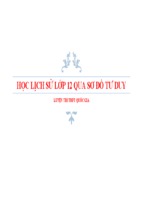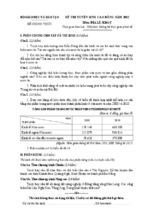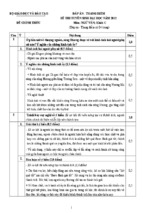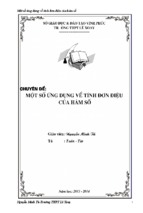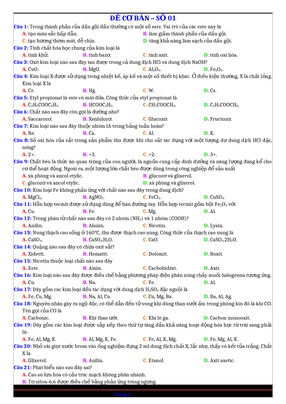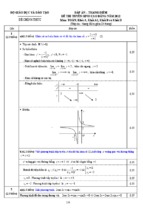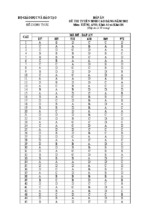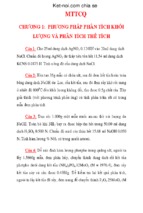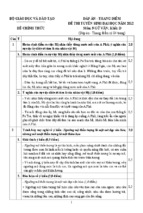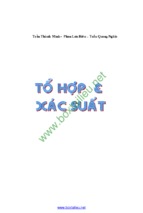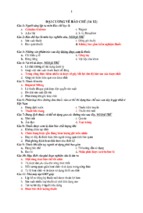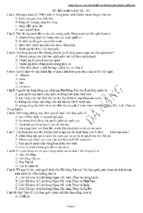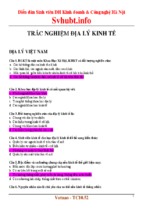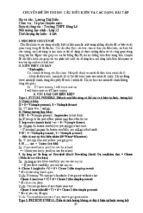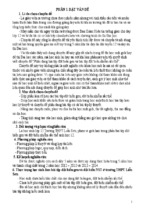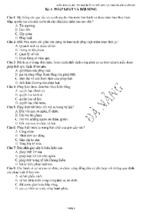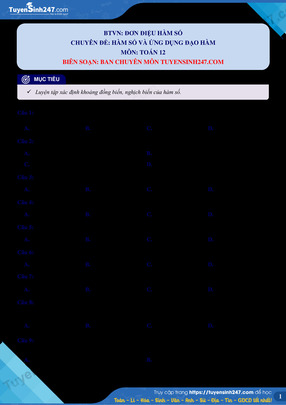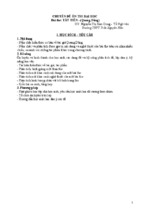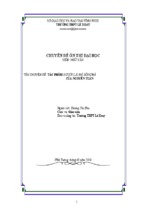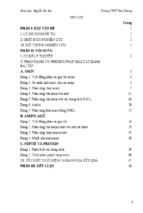1
VIETNAM NATIONAL UNIVERSITY, HANOI
COLLEGE OF FOREIGN LANGUAGES
POST GRADUATE DEPARTMENT
---------o0o---------
NGUYỄN PHƯƠNG NGỌC
AN ACTION RESEARCH ON THE EFFECTS OF
PRE - WRITING ACTIVITIES ON THE GRADE – 11
NON – MAJOR ENGLISH STUDENTS’ MOTIVATION
IN WRITING AT NGUYEN BINH KHIEM HIGH
SCHOOL HANOI
A MINOR M.A THESIS
Field
: METHODOLOGY
Code
: 601410
Supervisor
: TRẦN THỊ MẠNH, M.A
Ha Noi - 2008
2
ACKNOWLEDGEMENTS
This thesis could not have been completed without the help, encouragement and support
of a number of people who all deserve my sincere gratitude and appreciation.
First of all, I would like to express my deepest gratitude to Mrs. TRAN THI MANH, my
respectful supervisor, who has given me the great help to my study.
I am also very grateful to my colleagues at English Department of Nguyen Binh Khiem
High School, Hanoi, who have been willing to answer my questions and have given me
invaluable advice and suggestions on the research of how pre – writing activities affect to
students’ writing performance and on the completion of my research.
I also owe my sincere thanks to all of the students of the classes 11CT1, 11CH, of Nguyen
Binh Khiem High School, who have been the enthusiastic participants in my action
research. Without them, my action research could not been completed and successful.
I would like to send my thanks to my lecturers, my friends and my classmates for their
sincere comments and criticism
In the end, I would like to show my big gratitude to my beloved people, my husband and
my parents, who have constantly inspired and encouraged me to overcome difficulties to
complete this study.
Finally, a special word of thanks goes to my readers for their interest and comments on
this study.
Hanoi, August 15th, 2008
Nguyen Phuong Ngoc
3
ABSTRACT
When teaching writing skill to the 11th non – major English students at Nguyen Binh Khiem High
School the author of this research found out that pre – writing stages are very important in teaching
writing and it also has significant effects on the students’ writing performance. If students do not
prepare well enough, they can not write well, they can not even write anything in their notebooks.
The aims of carrying out this action research were twofold: (1) to investigate the current situation of
the teaching writing and learning writing of the grade 11th non – major students at Nguyen Binh
Khiem High School in common and the teachers’ attitudes toward the pre – writing activities in a
writing lesson in particular; (2) to find out how pre – writing stages affect students’ writing
performance. The Action Research consists of three main stages: Pre – Improvement stage, Trying –
out stage and Post – Improvement Stage. In the first stage, some lessons were observed to illustrate
the problem and then a survey was conducted to get ideas from students. After that the causes of the
problem was found out by consulting with colleagues, trainers and reading professional books/
journals for ideas and suggestions. In the second stage, strategies were designed for improvement.
During this stage, all things happened in the class were recorded. In the last stage, the Try- out was
evaluated by observing a lesson (Focusing on students’ improvement in a writing lesson at the end
of the Try – out stage) that illustrates the changes that have been made. Then the teacher reflected on
the reasons for those changes. Next, the researcher carried out a survey to get comments and
opinions from students. In the end, the researcher gave comments and conclusions about the study.
4
TABLE OF CONTENTS
Page
Acknowledgements...........................................................................................................i
Abstract............................................................................................................................ ii
Table of contents.............................................................................................................. iii
Abbreviations................................................................................................................... vi
PART ONE: INTRODUCTION
I. Rationale.......................................................................................................................1
II. Research questions...................................................................................................... 1
III. Methods of the study..................................................................................................2
III.1. Participants.............................................................................................................2
III.2. Instrumentation....................................................................................................... 2
IV. Research procedure....................................................................................................3
V. Scope of the study....................................................................................................... 4
VI. Design of the study.................................................................................................... 4
VII. Significance of the study.......................................................................................... 4
PART TWO: DEVELOPMENT
CHAPTER ONE: LITERATURE REVIEW
I.1. ACTION RESEARCH
I.1.1. What is action research?............................................................................ 5
I.1.2. Why does a teacher need action research?................................................. 6
I.1.3. How does a teacher carry out action research in a language classroom?.. 7
I.1.4. Summary.....................................................................................................8
I.2. WRITING.................................................................................................................9
I.2.1. What is writing?..........................................................................................9
I.2.2. Why teach writing?.....................................................................................9
I.2.3. Approaches to teaching writing..................................................................10
I.2.3.1. Controlled – to – Free Approach............................................................. 10
I.2.3.2. Free – Writing Approach.........................................................................10
I.2.3.3. Paragraph – Pattern Approach.................................................................11
I.2.3.4. The Grammar – Syntax – Organization Approach..................................11
5
I.2.3.5. Communicative Approach.......................................................................11
I.2.3.6. The Process Approach............................................................................. 11
I.2.4. What is pre – writing?................................................................................ 12
I.3. PRE – LESSON FACTORS AFFECTING STUDENTS’ PERFORMANCE IN
WRITING LESSONS......................................................................................................12
I.3.1. Student factors........................................................................................................ 12
I.3.1.1. Students’ learning styles..........................................................................12
I.3.1.2. Students’ motivation...............................................................................13
I.3.1.3. Students’ language level..........................................................................13
I.3.2. Teacher factors....................................................................................................... 14
I.3.2.1. Teachers’ teaching methods.................................................................... 14
I.3.2.2. Teachers’ knowledge...............................................................................15
I.3.2.3. Teachers’ instructions..............................................................................15
I.3.3. External factors......................................................................................................... 16
I.3.3.1. Time limitations.......................................................................................16
I.3.3.2. Classroom and materials restraints.......................................................... 16
I.4. THE WRITING PROGRAM FOR GRADE 11TH NON – ENGLISH MAJOR
STUDENTS AT NGUYEN BINH KHIEM HIGH SCHOOL........................................ 17
I.4.1. The objectives of the program.................................................................... 17
I.4.2. The teaching materials................................................................................18
I.4.3. The schedule of the course......................................................................... 18
CHAPTER TWO: ACTION RESEARCH PROCEDURE
II.1. Pre – Improvement stage..........................................................................................20
Step 1: Identifying the problem....................................................................................... 20
II.1.1. Identifying the problem.............................................................................20
II.1.2. Observing a lesson that illustrated the problem........................................ 20
II.1.3. Conducting a survey to get information from students............................. 22
Step 2: Finding causes of the problem.............................................................................24
II.1.4. Consulting with colleagues....................................................................... 24
II.1.5. Reading professional books or journals for ideas and suggestions...........28
II.2. Try – out stage..........................................................................................................28
Step 3: Designing strategies for improvement.................................................................28
6
Step 4: Trying out strategies and making notes on what happened in the class.............. 29
II.3. Post – Improvement................................................................................................. 29
Step 5: Evaluating the try – out........................................................................................29
II.3.1. Post – improvement class observation...................................................... 30
II.3.2. Post – improvement questionnaire for students........................................ 34
II.4. Summary.................................................................................................................. 38
PART THREE: CONCLUSION............................................................... 39
I.Summary of the main findings...................................................................................... 39
II. Implications for more effective writing lessons..........................................................39
II.1. To the teachers............................................................................................. 39
II.2. To the classroom facilities............................................................................40
III. Limitations and suggestions for further study........................................................... 40
IV. Conclusion................................................................................................................. 40
REFERENCES............................................................................................................... VII
APPENDICES................................................................................................................. IX
ABBREVIATIONS
7
NBK:
Nguyen Binh Khiem
MOET:
Ministry of Education and Training
SS:
Students
T:
Teacher
S:
Student
PART ONE: INTRODUCTION
8
I. RATIONALE
Nowadays English has become an international language because it is widely used in
many parts of the world. In the tendency of integration of the global economy, English is
one of the effective communicative tools for everybody. The role of English is considered
to be very important in the fields of economics, politics, science, culture and education.
Especially, Vietnam’s official membership of WTO on 7th November 2006 opened a new
door for integrating into the world economy, and more and more people want to learn
English for communicating with foreign partners, tourism, study tours, etc.
Thanks to the innovation of ways in teaching English, English lessons are taught with four
skills (speaking, reading, listening, writing) in one unit. Moreover, there exists three
stages – Pre - while – post - teaching in one lesson. This really helps students improve
their skills beside the grammar exercises to pass the exams.
When teaching writing skill to the 11th non – major English students at Nguyen Binh
Khiem High School the author found out that pre – writing stages are very important in
teaching writing and it also has significant effects on the students’ writing performance.
If students do not prepare well enough they can not write well, they can not even write
anything in their notebooks.
The author of this research decided to carry out the action research to find out how pre –
writing stages affect the students’ writing performance and whether the pre – lesson
activities are important to teachers of English at NBK High School. Based on the results
of this action research, some changes and improvements could be applied in the author’s
lessons, and some appropriate strategies needed to be designed with the hope that students
will work more effectively in a writing lesson. Hopefully that the results of this study
would be shared with any colleagues who had the same problem or anyone who is
interested in this study.
II. RESEARCH QUESTIONS
1. Do teachers highly appreciate the pre – writing activities in a writing lesson?
2. How do pre – writing activities affect the students’ writing performance?
III. METHODS OF THE STUDY
The study is basically a qualitative research, which employs the following methods:
1. Data is collected by means of three sets of questionnaires, one on the teachers and the
others on the students in pre – improvement stage and post – improvement one. The
9
questions are of the three – kinds: close – ended questions, open – ended questions and
scaling
2. Other sources of data come from writing tasks from the textbooks.
The analysis of the data hopefully will bring about reliable findings useful for the teaching
of writing to non – major students at Nguyen Binh Khiem High School, Hanoi.
III.1 Participants
The subjects chosen for the research include 80 grade 11th non – major English students in
class 11CT1, 11CH of Nguyen Binh Khiem High School with the survey questionnaires,
and 15 teachers who are currently teaching English. To be more specific, among 15
teachers answering the questionnaires, there was no male teacher. The teachers’ ages
range from 24 to 56. Their experience of teaching English varied from one year to 30
years. The research was carried out during the first term of the academic year 2007 – 2008
at Nguyen Binh Khiem High School.
III.2 Instrumentation
Instrumentation one: A set of questionnaires answered by the students in pre – writing
stage
The questionnaires were designed with 5 questions to elicit from students the information
about the situation of their class in pre – writing stage, the way the teacher carried out
these activities. The questions is multiple choice
Instrumentation two: A set of questionnaires completed by the teachers
This set of questionnaires were designed with the aim to find out the attitude of the
teachers toward teaching pre – writing activities in a writing lesson, the difficulties they
often meet while conducting these activities and solutions to solve the problem. In
addition, their suggestions of how to make the pre – writing activities effectively were
also mentioned. To complete the questionnaires, teachers had to tick the appropriate boxes
or to give answers.
Instrumentation three: A set of questionnaires answered by the students in post – writing
stage.
This was done with a view to exploring the changes that the teachers made to change the
situation, the changes from the students appreciated by themselves
Instrumentation four: A collection of students’ writing papers in both pre – improvement
stage and post – improvement one.
10
The researcher wants to find out the results of how pre – writing activities affect to
students’ writing performance. The students’ writing papers were analyzed to withdraw
the compared results.
IV. RESEARCH PROCEDURE
This action research consists of three main stages: Pre – Improvement stage, Trying – out
stage and Post – Improvement stage
Stage 1: Pre – Improvement
Step 1. Identifying the problem which was wished to solve or an area which was wished
to improve by:
i.
Observing a lesson that illustrated the problem
ii.
Conducting a survey to get information from students
Step 2 Finding causes of the problem by:
i.
Consulting with colleagues: a number of colleagues were asked to answer
three questions about the effectiveness of conducting the pre – writing
activities in writing lessons
ii.
Reading professional books/ journals for ideas and suggestions
Stage 2: Trying – out
Step 3: Designing strategies for improvements (plan for action)
Step 4: Trying – out the strategies (action) and making records of what happened in class.
Stage 3: Post – Improvement
Step 5: Evaluating the try – out by:
i.
Observing a lesson (Focusing on the students’ writing performance at the end
of try – out period) that illustrated the changes that have been made;
ii.
Reflecting on the reasons for those changes (which could include things that
had been improved or that had been got worse)
iii.
Carrying out a survey to get information from the students
iv.
Giving comments and conclusions.
V. SCOPE OF THE STUDY
This study was carried out in two English classes with 80 11th grade students at Nguyen
Binh Khiem High School in Hanoi. The research focused on how pre – writing activities
affect the student’ writing performances in writing lessons.
VI. DESIGN OF THE STUDY
The research consists of three main parts : Introduction, Development and Conclusion.
11
Part 1: Introduction presents the rationale, the research questions, the method of study, the
research procedure, the scope of the study, the significance of the study and the design of
the study.
Part 2: Development consists of Chapter one “Literature Review” and Chapter two
“Action Research Procedure”. In Chapter One, the theoretical background of action
research are introduced with its definition, three reasons to use it, and ways to carry it.
The concepts of writing, approaches to teaching writing and some pre – lesson factors
affecting students’ writing performance are also presented in this chapter. What is more,
the writing program for grade 11th non – English major students at NBK High School is
described in this chapter, too.
Chapter two namely “Action Research Procedure”
describes the procedure of this action research with the following main steps: defining the
problem, observing class, conducting a survey using questionnaires, collecting data and
analyzing data, and giving out conclusions from findings.
Part 3: Conclusion is the last part which offered a summary and suggestions for more
effective writing activities and some limitations and suggestions for further studies
VII. SIGNIFICANCE OF THE STUDY
Writing, one of the two productive skills, has always a significant position in language
teaching. Nevertheless, how to teach and learn writing effectively often poses great
problems to both teachers and students. For the teachers of English at high school, writing
is considered a difficult skill to teach. Some of them even ignore teaching writing skill
and focus only on grammar excercises for the exams. However, nothing is difficult if we,
the teachers make decision to make it easier. Hopefully , with a range of suggestions of
how to make pre – writing activities effectively in writing lessons introduced in this
research, it will be more motivating for the teachers to teach and make progress in
teaching writing Therefore, their students will be interested in writing lessons.
12
PART TWO: DEVELOPMENT
CHAPTER ONE: LITERATURE REVIEW
I. 1. ACTION RESEARCH
I.1.1. What is action research?
According to Jerry G. Grebhard (1999), the concept of action research originated in the
work of Kurt Lewin (1948,1952). He was a social psychologist who brought together
experimental approaches to social – science research and the idea of “social action” to
address social issues. Stephen Corey (1952,1953), a Columbia University Professor, was
among the first to use action research in the field of education. He argued that formal
research following a scientific method had little impact on educational practice. Through
action research, he argued, changes in educational practice were possible.
In terms of what action research was, having considered what it was not, action research
had been defined in many different ways. In Stephen Corey’s definition “Action research
is a way in which teachers try to study their own problems scientifically, in an effort to
evaluate, guide and correct their procedures”. Tsui’s definition was more detailed and
simpler: “Action research is a very effective way of helping teachers to reflect on their
teaching and to come up with their own alternatives t improve their practice” (Tsui, 1993)
In another way, action research was mentioned at two levels by Grebhard and Oprandy:
“At one level, action research is about teachers identifying and posing problems, as well
as addressing issues and concerns related to the problem. It is about working toward
understanding and possibly resolving these problems by setting goals and creating and
initiating a plan of action, as well as reflecting on the degree to which the plan work. At
another level, it can be about addressing educational practices that go beyond each
teacher’s classroom” (Grebhard and Oprandy,1999).
In the “Longman Dictionary of Language Teaching and Applied Linguistics” Richards,
J.C and Platt, J.H. gave the following definitions of action research:
In the general meaning, it is “…research which has the primary goal of finding ways of
solving problems, bringing about social change or practical action, in comparison with
research which seeks to discover scientific principles or develop general laws and
theories”.
13
In teacher education, it is “…..teacher – initiated classroom research which seeks to
increase the teacher’s understanding of classroom teaching and learning and to bring
about improvements in classroom practices”
In brief, action research is a kind of scientific study which is often carried out by a teacher
or an educator in order to solve a practical problem in a classroom. As it was named, it
focuses mainly on the actions of both students and teachers. So, it can solve the problems
which are related to all actions and activities in a classroom. The problems which are
solved by action research are often practical and useful for teachers.
I.1.2. Why does a teacher need action research?
Action research in schools, colleges or universities solves everyday practical problems
experienced by teachers, rather than the “theoretical problems” defined by non – teaching
researchers. It should be carried out by the teachers themselves or by someone they
commission to carry out for them.
Action research in education focuses on the three related stages of action:
1. Initiating action, such as, adopting a text, choosing an alternative assessment
strategy.
2. Monitoring and adjusting, such as ,seeing how a pilot project is proceeding,
assessing the early progress of new programme, improving a current practice.
3. Evaluating action, such as, preparing a final report on a completed project”
(Sagor, 1992)
If the teacher was trained to conduct action research, he could solve his problems on his
own or in collaboration with other teachers. Anders (1988), Curtis (1988) and Tsui (1993)
gave three reasons why a teacher needed action research:
- to solve own problems in a scientific process and improve own practice
- to adapt theory (findings of conventional research) to practice (own problems)
- to share the results of action research with other teachers
Moreover, action research was also for a teachers’ professional developments. He
would become a better teacher because he knew how to find out and solve his problems in
teaching scientifically on his own. This also showed his dynamic, activeness and
imagination in his teaching job.
I.1.3. How does a teacher carry out action research in a language classroom?
Tsui (1993) suggested 5 steps in conducting action research:
Step 1: Identifying problems you wish to solve or an area you wish to improve by:
14
-
reviewing an audio – or a video – taped lesson and the transcription of a segment
of the lesson that illustrates the problem.
-
Conducting a survey to hear from your students
Step 2: Finding causes of the problem by:
-
consulting with your colleagues, trainers
-
reading professional books/ journals for ideas and suggestions
Step 3: Designing strategies for improvement (plan for action) and writing a proposal for
action research
Step 4: Trying out the strategies (action) and keeping a diary of what happened in the
class
Step 5: Evaluating the try – out by:
-
reviewing a lesson (taped at the end of the try –out period) that illustrated the
changes that have been made and
-
reflecting on the reasons for those changes (which could include things that have
been improved or that have been gotten worse)
-
carrying out a survey to get information from students.
Other authors such as Kemmis and Mc Taggart (1998), Andy Curtis (1988) and Nunan
(1989) also recommended the similar steps in doing action research in a classroom.
Different from Tsui, in the step of “Collecting data and identifying the problem”, Nunan
(1992) suggested that teachers should observe and make notes on what their learners and
themselves said and did in class, and then, based on these observations, identified positive
ways to bring about this change.
In my opinion, observing the class and making notes are feasible for a teacher to
implement his/ her action research where cassette recorders or camcorders are not
available.
A necessary component of action research is collaboration among different people. They
are teachers, their colleagues and students, who should be willing to talk with each other
about the problems and find out the solutions together, as well as help each other in
implementing classroom – centered action research projects. It also needs the
collaborative efforts of students who participate in the action research project. Students’
collaboration plays an important role in the success of the action research project.
I.1.4. Summary
Action research is a kind of scientific study carried out by a teacher which solves the
practical problems in a classroom. The teacher needs action research to adapt theory
15
(findings of conventional research) to practice (his/ her own problems). Action research
consists of three stages:
1. Pre – improvement: Firstly, the teacher identifies the problem in his teaching job
in class. He. She observes by himself/herself or asks somebody to observe or has
his/ her lessons video – taped in class to get data to prove the problem. He/ she
also proves the problem by conducting a survey to get information from his/ her
students. Secondly, the teacher tries to find out the causes of the problem from
professional books or journals, colleagues and students.
2. Try –out: The teacher designs the strategies for improvement and tries them out in
some following lessons. Next, a lesson is observed or video – taped to get data to
illustrate the changes and improvements.
3. Post-improvement: The teacher reflects on the reasons for the changes and
improvements. To ensure the success of the applied strategies in action research a
survey is necessary to get the evaluation from students. From the results of the
action research some conclusions and comments will be made.
Action research can be carried out in collaboration with other teachers or educators and it
needs the supports from both students and education administrators. Its results should be
popularized and shared with anybody who is interested in.
I.2. WRITING
I.2.1. What is writing?
In teaching a language, writing is considered one of the four language skills (speaking,
listening, reading and writing) that a learner is expected to master. Writing is the process
in which the writer expresses his thoughts or ideas in the form of handwriting. “Writing is
communicating. Good writing gets your ideas out of your head and into the reader’s head
without losing or distorting those ideas” (Leki, 1976). To understand thoroughly the
nature of writing, some more academic definitions of writing should be studied.
According to “Oxford Advanced Learner’s Dictionary” (1989), writing is to
“make letters or other symbols on a surface (usually paper), especially with a pen or
pencil”. Writing, in Davies’s point of view, involved two kinds of skills. The first ones
were low – level skills such as handwriting or typing, spelling, constructing grammatical
sentences, organizing and sequencing, structuring, drafting, and editing. Byrne (1988)
gave a long and complex definition which might be summarized as follows: writing is the
act of forming graphic symbols (letters or combinations of letters) which were arranged to
16
form sentences, and we produced a sequence of sentences arranged in a particular order
and linked together in certain way, on a flat surface of some kind.
In conclusion, Byrne’s definition can be considered one of the most complete
definitions of writing because it covers all of the features of writing given by three
above – mentioned authors.
I.2.2. Why teach writing?
When we learn a second or a foreign language, we learn to communicate with other
people: to understand them, talk to them. An integral part of participating fully in a new
culture setting is learning how to communicate when the other person is not right there in
front of us, listening to our words and looking at our gestures and facial expressions.
Visitors to another country will often have to leave a note for the mailman, fill out a
customs declaration form, give written instructions, or write a thank – you letter.
Raims (1983,p3) thinks there is “….an additional and very important reason:
writing helps our students learn.”. She shows three ways in which students can learn
through writing:
-
First, writing reinforces the grammatical structures, idioms and vocabulary that we
have been teaching our students.
-
Second, when our students write, they also have a chance to be adventurous with
the language, to go beyond that they have just learned to say, to take risks.
-
Thirdly, when they write, they necessarily become very involved with the new
language, the effort to express ideas and the constant use of eye, hand and brain is
a unique way to reinforce learning.
Writing is a productive skill, so it is writing that provides students with a chance to put all
those language itself and practice communicative skills at the same time. Through the act
of writing students will realize what they are already good at and what they still need to
learn to become a better and more effective writer (also a better learner) By far, the
difficult question for teachers to answer is not “why teach writing”, but it is how to create
good reasons for writing.
I.2.3.Approaches to teaching writing
Nowadays there are many different approaches to teaching writing. In this part six
approaches to teaching writing presented by Ann Raims (1983, pp 5 – 10) were
mentioned.
According to Ann Raims (1983, pp 5 – 10), there were six approaches to teaching
writing namely: Controlled – to – Free Approach, Free – Writing Approach, Paragraph –
17
Pattern Approach, Grammar – Syntax – Organization Approach, Communicative
Approach and Process Approach.
I.2.3.1 Controlled – to – Free Approach
According to this approach mistakes shown up in written work was regarded as a major
problem. The teacher assumed that students made mistakes because they wrote what they
wanted freely. This approach stressed the importance of control in teaching writing skills
to students in early stages. Students were taught how to write and combine various
sentence types and manipulation exercises were used to give students the experience of
writing connected sentences.
The amount of control would be reduced gradually and students were asked to
exercise meaningful choice. At the next stages, students might be given a good deal of
guidance and content, but allowed some opportunities for self – expression. This approach
also emphasized step – by – step learning and formal correction
I.2.3.2 Free – Writing Approach
This Free – Writing encouraged students to write as much as possible and as quickly as
possible – without paying attention to mistakes. The important thing students did was to
get their ideas down on a paper. The drawbacks of this approach were that many students
wrote badly because they did not write enough and for the same reason they felt inhibited
when they picked up a pen to write. This approach might be useful when writing a journal
or a diary.
I.2.3.3 Paragraph – Pattern Approach
This Paragraph – Pattern Approach stressed the importance of paragraph as the basic unit
of written expression. Students were taught how to construct and organize paragraphs.
This approach helped students express themselves effectively at a level beyond the
sentence.
I.2.3.4 The Grammar – Syntax – Organization Approach
Writing can not be seen as composed of separate skills which are learned one by one. So
some teachers devise writing tasks that lead students to pay attention to organization
while they also work on the necessary grammar and syntax. This approach links the
purpose of a piece of writing to the forms that are needed to convey the message.
I.2.3.5 Communicative Approach
This Communicative Approach emphasized the communicative role of writing. Students
should have a reason for writing and think about whom they wrote to or for. This
18
approach required situations which allowed them to write purposefully. This approach
motivated students to write and showed how writing was a form of communication.
I.2.3.6 The Process Approach
In this approach, particular stress is paid on a cycle of writing activities which move
learners from the generation of ideas and the collection of data through to the
“publication” of a finished text:
PRE – WRITING
(Specify the task/ planning and outlining/ collecting data/ making notes)
↓
COMPOSING
↓
REVISING
(Reorganizing/ shifting emphasis/focusing information and style for your readership)
↓
EDITING
(Checking grammar/ lexis/ surface features)
So in the Process Approach, students did not write on a given topic in a restricted time
and gave their writing assignments to their teachers to correct. They explored a topic
through writing in an unrestricted time, showing their teachers and each other their drafts,
and using what they wrote to read over, think about, and moved them on to a new ones.
Teachers could give their feedbacks on the content of what students have written in their
drafts. The writing process became a process of discovery. That was the discovery of new
ideas and new language forms to express those ideas.
To sum up, there is no one perfect way to teach writing. We teachers have to take
into consideration the many factors of our context before deciding which approach to
apply or very likely, develop one of our own which is the combination of some
approaches and which suits our settings best.
I.2.4. What is Pre - Writing ?
For most of us, getting started is often the hardest part of writing. A blank page,
begging to be filled with ink, can be intimidating, especially when our words come slowly
or when our minds go blank. Pre – writing is considered to be very important in teaching
writing. Smith (1989) stated that Pre – writing is the complex network of initial mental
sequences we undergo when we write a paper. In addition, Richmond (1985) pointed out
that Pre – writing is the first stage of the writing process and is also called the idea –
19
generating stage which stretches back to include anything that you have ever done or
have ever been that might have given you ideas to write about
I.3. PRE - LESSON FACTORS AFFECTING STUDENTS’ PERFORMANCE IN
WRITING LESSONS
Students ‘performance in writing lesson can be affected by a variety of factors originating
from students, teachers and other external factors. In the following sections, some of the
major factors will be discussed.
I.3.1. Student factors
I.3.1.1. Students’ learning styles
Harmer (2001) emphasizes the importance of understanding that there are different
individuals in our class if we are to plan appropriate kinds of activities for them. Different
individuals may have different learning styles, prefer different kinds of work, and expect
different degrees of care and attention from the teacher. This can be seen clearly that there
are different reactions from students toward the pre – lesson stage. We can conclude with
certainty that if teacher realizes the differences among the individuals in the class when an
activity is in progress, the students will participate in the lesson actively.
I.3.1.2. Students’ motivation
Regarding the issue, there are sample definitions of motivation. Lightbown and Spada
(1999) consider motivation a complex phenomenon and define it in terms of two factors:
learners’ communicative needs and their attitudes towards the second language
community while Harmer (2001) defines motivation simply as “some kind of internal
drive which pushes someone to do things in order to achieve something”. No one can
deny the importance of motivation towards the success in learning a foreign language so
we have to understand the sources of motivation. According to Harmer, the sources of
motivation are diversified. They may derive from the society we live in, significant others
like parents or old siblings, the teacher and the method. Among these sources, the teacher
and the method may be of the most importance. For the teacher, his or her attitudes and
enthusiasm help create a positive classroom atmosphere. For the method, it means
involving both teacher and students’ confidence shown in the way of teaching and
learning. If either loses this confident motivation, the chance of success in learning a
language will be very small.
Downs (2000) also points out some conditions that help increase students’ motivation. He
says that motivation increases when students feel acknowledged and understood, when
20
students are confident they can succeed, when language has a communicative purpose,
and when students take responsibility for their own learning.
Clearly, motivation plays an important role in the success of language learning in general
but we may wonder how much or to what extent motivation accounts for students’
participation in pre – lesson stage. We may not give the exact answer but we can conclude
with certainty that the degree of motivation is directly proportional to the level of
involvement in pre – lesson stage in common and particularly in students’ performance in
writing lesson. To be more concrete, the more motivated students are, the more actively
they will participate in the lesson.
I.3.1.3. Students’ language levels
According to Harmer (2001), in a class where students’ language levels are different,
teacher may have some difficulties choosing a suitable teaching method, language and
activities used in class. Harmer claims that some techniques and exercises are suitable for
some students but less appropriate for others. The language we use in classroom and in
the materials we expose to students must be carefully chosen concerning the complexity,
length and genre. With regard to Topic and Genre Harmer says that if students are not
interested in the topics we are asking them to talk about, they are unlikely to invest their
language production with the same amount of effort as they would if they were excited by
the subject matter. If they are unfamiliar with the type of activity we are asking them to
talk about, they may find it hard to engage themselves with the task we have given to
them. Concerning the topic and genre Harmer (2001) suggests that teachers should take
some issues into consideration such as choosing interesting topics, creating interest in the
topic, activating schemata, varying topics and genre and providing necessary information.
In writing lesson, we do not have the chance to choose the topic because of its various
writing tasks. However, teacher should choose the suitable genre or activities to motivate
students.
sIn brief, the limitation in the students’ language levels can directly affect their
participation however much they like the activities. We, therefore, should choose the
topics as well as the kinds of activities of their levels to encourage their participation.
In conclusion, those are the main factors originating from students’ side that may
affect students’ participation in classroom activities. For each student, the degrees of
effect of those factors may vary and within one factor the degrees of effect on each
student are different. First, in a class may exist different learning styles. The teacher
should identify which group a student belongs to, this may help students overcome the
- Xem thêm -

